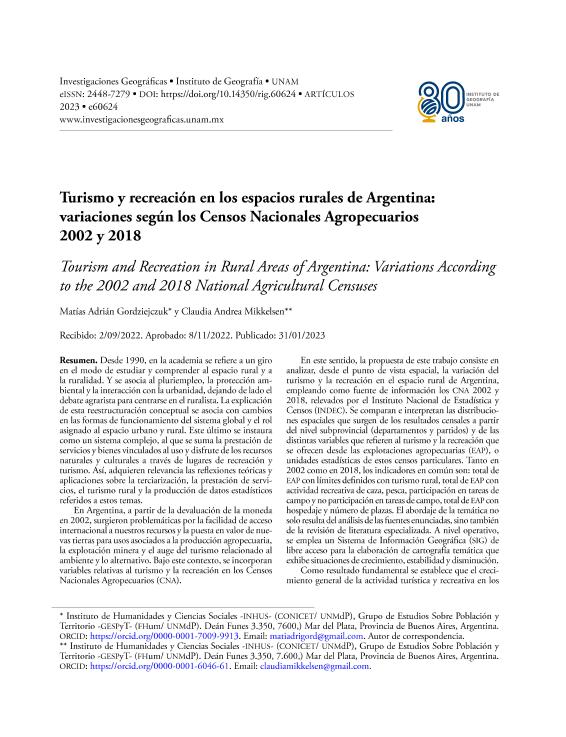Artículo
Desde 1990, en la academia se refiere a un giro en el modo de estudiar y comprender al espacio rural, que consiste en el desenfoque del debate agrarista y la ampliación de la mirada hacia las ruralidades. Dentro de esta reestructuración conceptual, adquieren relevancia las reflexiones teóricas y aplicaciones sobre la tercerización, la prestación de servicios, el turismo rural y la producción de datos estadísticos referidos a estos temas. En este sentido, la propuesta de este trabajo consiste en analizar desde el punto de vista espacial la variación del turismo y la recreación en el espacio rural de Argentina, empleando como fuente de información los Censos Nacionales Agropecuarios 2002 y 2018, relevados por el Instituto Nacional de Estadística y Censos. Se comparan e interpretan los resultados censales a partir del nivel subprovincial (departamentos y partidos) y de las distintas variables que refieren al turismo y la recreación que se ofrecen desde las explotaciones agropecuarias, o unidades estadísticas de estos censos particulares. El abordaje de esta temática no solo resulta del análisis de las fuentes enunciadas, sino también de la revisión de literatura especializada y, a nivel operativo, el uso de Sistema de Información Geográfica para la elaboración de cartografía temática. Como resultado fundamental se establece que, si bien el crecimiento general de la actividad turística y recreativa en los espacios rurales de Argentina es un hecho que señala la evidencia estadística oficial, el decrecimiento en determinados sectores del mapa nacional también lo es. Since 1990, academic sources have reported a shift in the approach to studying and understanding the rural environment and rurality. This shift is associated with multi-employment, environmental protection, and interaction with urbanity, leaving aside the agrarian debate to focus on the ruralist approach. The explanation for the conceptual restructuring is associated with changes in the functioning modalities of the global system and the role assigned to urban and rural scopes. The latter is a complex system, in addition to the provision of services and goods linked to the use and enjoyment of natural and cultural resources through recreation sites and tourism. Thus, theoretical reflections and applications on outsourcing, service provisioning, rural tourism, and the production of statistical data on these topics become relevant. In Argentina, the devaluation of the currency in 2002 triggered issues arising from the ease of international access to our resources and the valuation of new land for uses associated with farming, mining, and the surge of environmental and alternative tourism. In this context, variables related to tourism and recreation have been incorporated into the National Agricultural Census (CNA, for its acronym in Spanish). In this sense, the aim of this work is to analyze, from a spatial perspective, the variation of tourism and recreation in rural areas of Argentina, based on the information gathered by the 2002 and 2018 CNAs surveyed by the National Institute of Statistics and Censuses (INDEC). We compared and interpreted the spatial distributions arising from census results at a sub-province level (departments and parties) and the different variables that refer to tourism and recreation offered by the statistical units of these particular censuses, named agricultural developments (EAPs). The common indicators in 2002 and 2018 are the total number of EAPs with defined boundaries and rural tourism, the total number of EAPs with recreational hunting, and fishing, with and without involvement in field tasks, and the total number of EAPs with accommodation facilities and their capacity. The approach to the subject results not only from the analysis of the stated sources, but also from the review of specialized literature. At the operational level, a free-access Geographic Information System (GIS) was used to construct thematic cartography illustrating cases of growth, stability, and decline. A key finding is that the overall growth of tourism and recreational activities in rural areas of Argentina is a fact indicated by official statistical evidence. Similar to other countries, these services have become a major and emerging sector of the economy as a result of global processes and trends such as the return to nature, the reminiscence about breeding spaces, the preservation of traditions, and the vision of tourism as alternative development. However, geographic disaggregation allows for appreciating the decrease in certain areas of the map. In this way, the present work represents a first spatial photographic approach with a potential national scope suitable for conducting interpretive zooms in the future and for conducting complex analyses and interpreting rural tourism and recreation together with other sources and variables. We expect that the indication of particular cases will represent a useful contribution to the selection of case studies and decision-making through the targeting and implementation of sectoral policies.
Turismo y recreación en los espacios rurales de Argentina: variaciones según los Censos Nacionales Agropecuarios 2002 y 2018
Título:
Tourism and Recreation in Rural Areas of Argentina: Variations According to the 2002 and 2018 National Agricultural Censuses
Fecha de publicación:
02/2023
Editorial:
Universidad Nacional Autónoma de México
Revista:
Investigaciones Geográficas
ISSN:
0188-4611
Idioma:
Español
Tipo de recurso:
Artículo publicado
Clasificación temática:
Resumen
Palabras clave:
TURISMO RURAL
,
AGROTURISMO
,
EXPLOTACION AGROPECUARIA
,
DISTRIBUCION ESPACIAL
Archivos asociados
Licencia
Identificadores
Colecciones
Articulos(INHUS)
Articulos de INSTITUTO DE HUMANIDADES Y CIENCIAS SOCIALES
Articulos de INSTITUTO DE HUMANIDADES Y CIENCIAS SOCIALES
Citación
Gordziejczuk, Matías Adrián; Mikkelsen, Claudia Andrea; Turismo y recreación en los espacios rurales de Argentina: variaciones según los Censos Nacionales Agropecuarios 2002 y 2018; Universidad Nacional Autónoma de México; Investigaciones Geográficas; 110; 2-2023; 1-19
Compartir
Altmétricas




